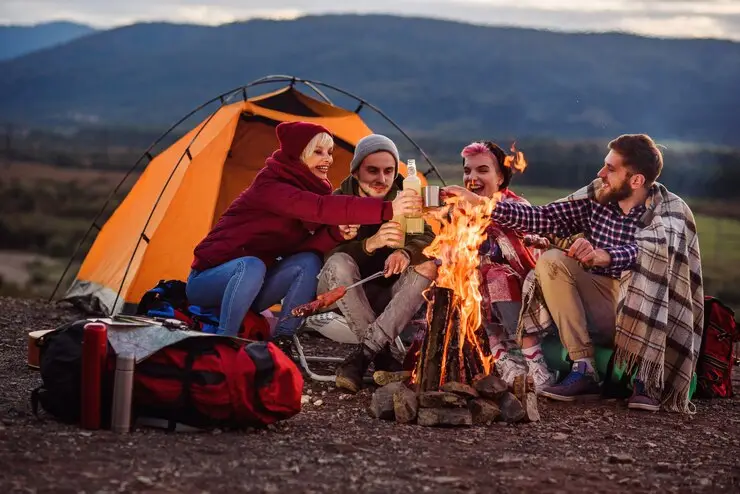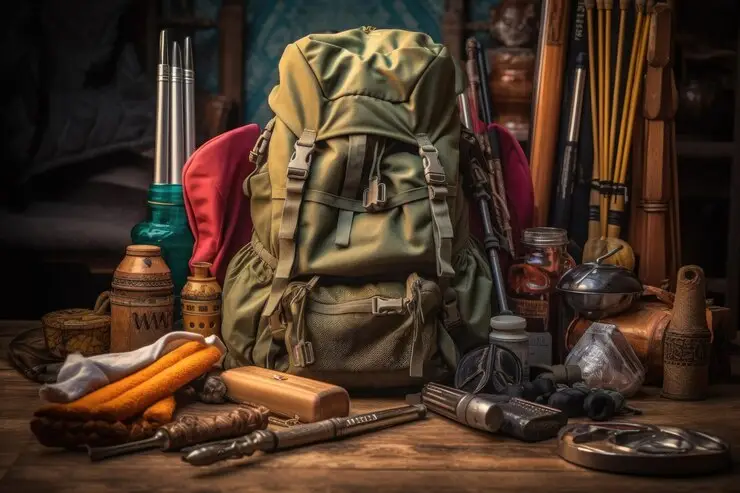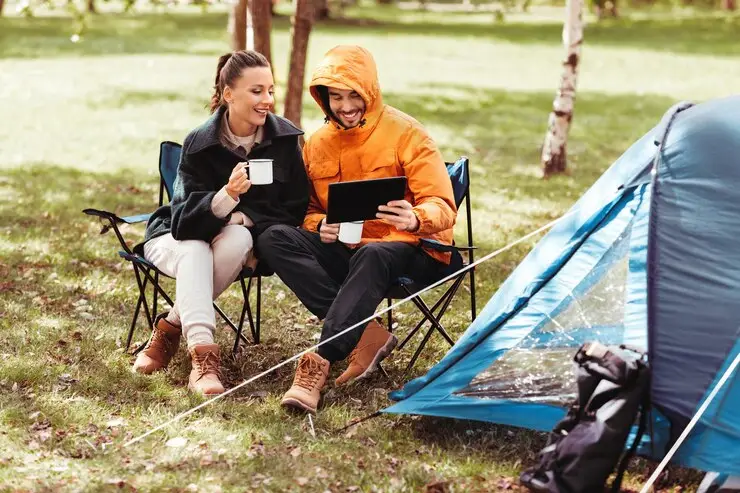
Table of Contents
Introduction
The joys of hiking and camping go way beyond spending time outdoors—they nourish the spirit, give the body a workout, and forge memories for a lifetime. A solo getaway to commune with nature, a family trip to unwind and reconnect, a budget-orientated break from the workday grind—whatever your plans are for an outdoorsy escape in 2025, this guide will get you up to speed on everything you’ll need for a successful trip.

Camping and Hiking Gear: A Complete Guide
Before hitting the trails, let’s discuss gear. The right gear can make or mar the outdoor experience. Here are a few must-have items to get you started:
Backpack: Your backpack is your number one trail buddy. Opt for a light, durable pack with adjustable shoulder straps and plenty of compartments. Osprey and Deuter tend to have some of the best options.
TENT: Your home from home. Buy a light, simple-to-place-up tent that will withstand the conditions you are expecting Scroll down for more info on tents!
Sleeping Bag and Pad: A warm, comfortable sleeping bag as well as an insulated sleeping pad. Stay Warm. Check the temperature rating and material.
Clothing: Layering is key. Bring moisture-wicking base layers, insulating mid-layers, and a waterproof outer layer. Don’t forget socks and a hat!
Footwear: Boot or trail shoe with good support and grip. No blisters if you break them in before your trip.
Navigation Tools: Even if you carry a GPS app, bring along a physical map and compass as alternatives.” Know how to use them.
Cooking Equipment: A camping stove, lightweight cookware, and utensils are essential. We’ll cover how to select the perfect camping stove below.
Waterfiltration: Keeping hydrated is essential. Bring along a water filter, purification tablets, or a UV purifier to ensure your drinking water is safe.
First Aid Kit: A properly stocked outdoor first-aid kit is important. Bandages, antiseptic wipes, and any personal medications are all examples of items to include.
Miscellaneous Items: Be sure to pack a headlamp, multi-tool, fire-starting materials, and biodegradable soap.

Top Backpacking Tents: Lightweight Options for Your Next Adventure
When it comes to backpacking, every ounce matters. Best Lightweight Tents in 2025 Here are the best lightweight tents.
- Big Agnes Copper Spur HV UL2: A favourite of backpackers, this ultralight tent is spacious and easy to set up. It’s good for two people and weighs a little over 3 pounds.
- NEMO Hornet Elite: If you’re hiking solo, this tent strikes a fine balance of weight (less than 2 pounds) and durability. The layout is simple, and the interior is deceptively spacious.
- MSR Hubba Hubba NX: A two-person tent that is trusted, weather-resistant, and packed small. It’s a little heavier than the Copper Spur, but the extra durability is worth it.
- REI Co-op Flash Air: Good beginner tent. Cheap, light, single wall, so doesn’t breathe terribly well in really moist conditions but will be just dandy in arid climates.
When it comes to choosing a good tent, there are so many factors to take into consideration: the weather, the number of occupants, and your level of comfort with weight. But remember to install it at your house.

Choosing the Right Camping Stove for Your Next Trip
There’s nothing like cooking in the great outdoors, and this outdoor stove only makes things better. Here’s how to choose:
Fuel Type
- Canister stoves are compact and convenient, like the Jetboil, but they don’t work as well in very cold temperatures.
- Liquid fuel stoves (like the MSR WhisperLite) are versatile and may perform better in extreme conditions.
- Solid-fuel stoves and wood-burning stoves are lightweight and eco-friendly but slower to cook with.
Cooking Style
- If you’re boiling water for freeze-dried meals, a simple canister stove works great.
- When complex cooking is required, a more complex stove with flame adjustment is desirable.
Weight and Size
Backpackers need stoves that are small and light, but campers with car access will be able to tolerate heavier and bulkier stoves.
Wind Resistance
Preference is given to models that have windscreens built into them or have very good wind performance.
Here are some of the better choices for 2025:
- Jetboil MiniMo: Boils fast & can simmer
- MSR PocketRocket 2: Lightweight, inexpensive, and fuel-efficient
- Biolite CampStove 2+: This is a wood-burning stove that also charges your devices!

Key Safety and Survival Precautions to Practice When Camping Alone
Being in a solo tent is highly rewarding, but more planning and precautions are needed. Here’s what you need to know:
- Update your itinerary: Ensure that the trusted person knows your starting and ending locations as well as when you expect to return.
- Pack smart: Ensure to have enough supplies and bring, albeit minimally, everything you would need to survive should you get lost, even bringing extra food, water, and a rechargeable portable outlet to power your phone or GPS.
- Develop your survival skills: digging your heels in on fire, starting, pitching a tent, and navigating without your GPS.
- Disclaimer: Trust your gut. Stay out of sketchy areas and away from wildlife.
- Emergency Preparedness: Bring a PLB or satellite communicator for emergencies. It could save your life.

Family Camping Tips: Making the Most of Your Family Holiday
Family Camping Great bonding and memories Here’s how to make sure it’s a fun, low-stress trip:
- Include Everyone: Let each family member get involved with the planning. Children can select activities, and adults can share duties.
- Pack for Comfort: Pack extra blankets, favourite snacks, and some fun activities such as board games or a frisbee.
- Start Simple: Pick a campsite with amenities such as restrooms and picnic tables if it’s your family’s first trip.
- Safety First: Reinforce basic outdoor safety rules, such as staying within sight and avoiding anything unfamiliar, be it a plant or an animal.
- Add Fun Factor: Plan activities like hiking, fishing, or storytelling in front of a campfire.

Budget Camping: Tips and Tricks for Camping on a Budget
It is not necessary to spend a lot of money on camp. Here’s how to experience the great outdoors without going broke:
Borrow or Rent Gear: Don’t splurge on equipment borrow or rent what you need.
Shop Sales and Secondhand: Search for deals at outdoor stores, or browse thrift shops and online marketplaces.
Home-Brew Solutions: Construct your own gear where feasible. A soda can makes a simple stove, for example.
Stay at Free Campsites: You can find many free or low-cost campsites on public land. Websites like FreeCampsites.net are great resources.
Meal Prep: Plan healthy and budget-friendly meals. Canned goods, pasta, and oatmeal are inexpensive staples.
Conclusion
In 2025, the great outdoors will be beacons with countless opportunities for adventure, connection, and growth. With the right gear, careful planning, and common sense, you can make unforgettable memories in the great outdoors. There is much to love, whether you’re travelling alone, with a family, or on a budget.
Frequently Asked Questions (FAQs)
- What’s the best time of year for camping and hiking?
- Spring and fall are ideal for mild weather and fewer bugs, but it depends on your location.
- How do I keep food safe from wildlife?
- Use a bear canister or hang food in a tree at least 200 feet from your campsite.
- Can I camp without a tent?
- Yes, you can use a hammock, bivy sack, or sleep under the stars, but be prepared for weather changes.
- What’s the best way to start hiking as a beginner?
- Start with short, easy trails and gradually work up to more challenging hikes.
- How do I find campsites?
- Use apps like AllTrails, Hipcamp, or check with local parks and recreation departments.
- What do I do if I get lost?
- Stay calm, stay put, and use your map, compass, or GPS to reorient yourself. Signal for help if necessary.
- How much water should I bring?
- Aim for at least 2 liters per person per day, plus extra for cooking and emergencies.
- Is camping safe for kids?
- Yes, with proper preparation and supervision, camping is a safe and enriching experience for children.
- How do I prevent blisters while hiking?
- Wear moisture-wicking socks, break in your shoes, and use blister prevention products like moleskin.
- Can I camp during the winter?
- Yes, but you’ll need specialized gear like a four-season tent and a cold-weather sleeping bag.
- What should I do with my trash?
- Follow Leave No Trace principles: pack out all your trash and dispose of it properly.
- How do I handle bad weather while camping?
- Check the forecast, pack rain gear, and have a backup plan for extreme conditions.
- Are campfires allowed everywhere?
- No, always check local regulations and fire bans before starting a campfire.
- How can I make camping eco-friendly?
- Use reusable gear, stick to marked trails, and follow Leave No Trace principles.
- Do I need permits for camping or hiking?
- Some areas require permits, especially for popular trails or overnight stays. Research ahead of time.




